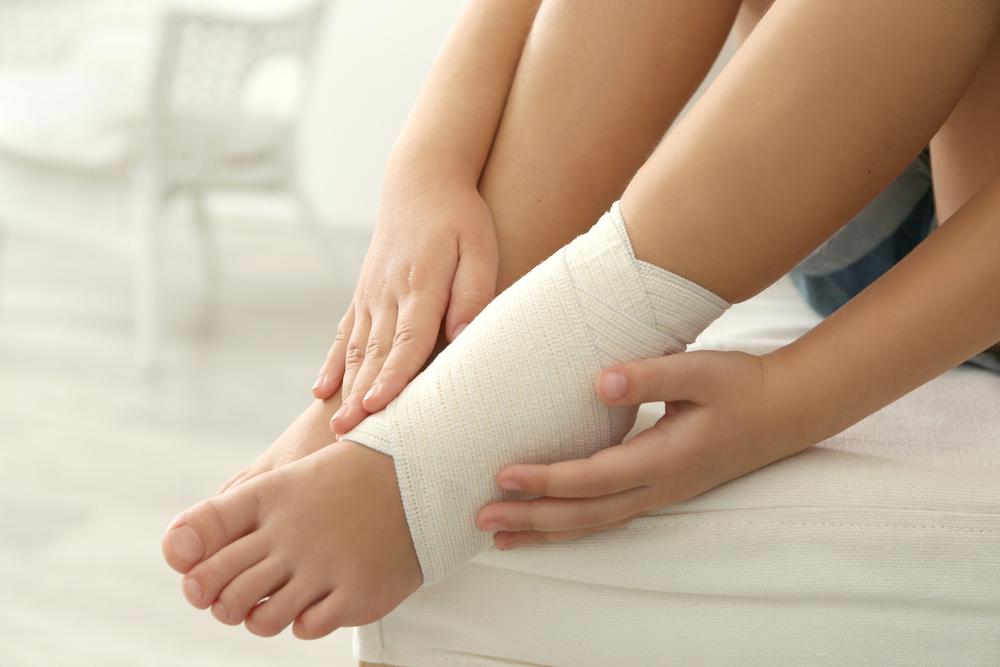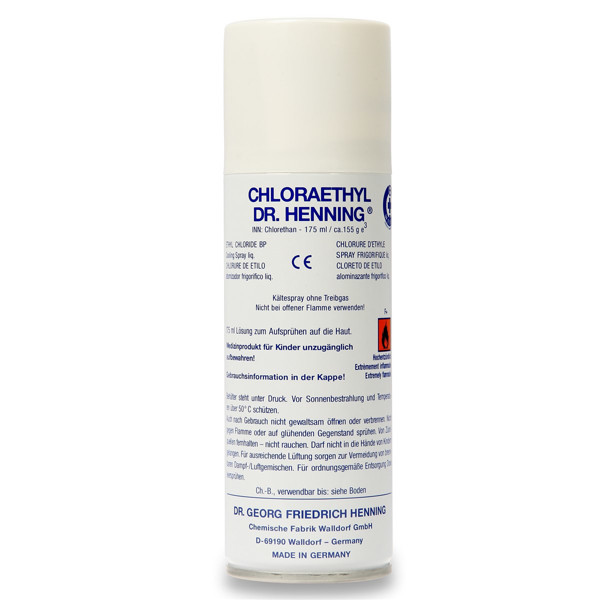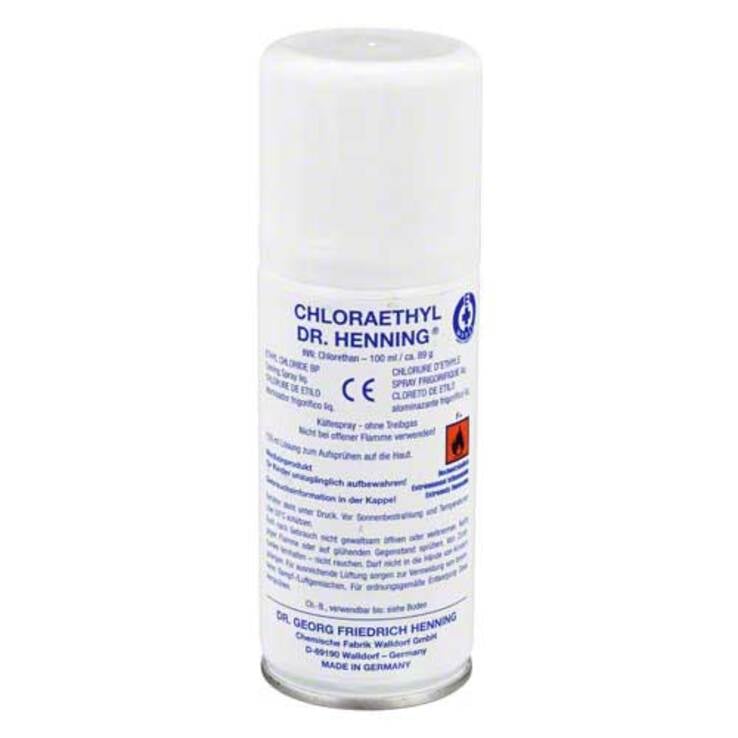Use of Chloraethyl (Dr. Henning Spray 175ml) in medicine and sports
Principle of action of ethyl chloride
Ethyl chloride (Chloraethyl) works on the principle of cooling. When sprayed onto the skin, it evaporates quickly, thus removing heat from the skin's surface. This causes local cooling, which reduces pain and decreases inflammation. Because of this property, ethyl chloride (Chloraethyl) is often used for quick pain relief, for example, in sports injuries or during procedures that require short-term anesthesia.
Potential uses in medicine
- Treatment of trauma and bruises: Ethyl chloride (Chloraethyl) is effective in reducing pain and swelling after soft tissue injuries.
- Diagnostic procedures: Used before performing minor skin procedures or others that may cause discomfort.
- Dermatology: Can be used as a local anesthetic before removing skin lesions or performing other skin procedures.
- Sports medicine: Frequently used in treating muscle injuries, bruises, and other sports-related injuries.
Forms and use of ethyl chloride
Ethyl chloride (Chloraethyl) is most commonly found in the form of a spray aerosol, which allows for easy and quick application to the desired skin area. Due to its cooling properties, it is a popular choice in various medical fields.
Treatment of trauma and bruises
- How to use: Ethyl chloride aerosol should be sprayed on the affected area from a distance of about 15-30 cm. It is sprayed for 3-5 seconds until the skin turns slightly white. This causes rapid cooling, which reduces pain and decreases swelling.
- Forms: Most commonly used in aerosol form, as it allows for quick and precise coverage of the desired area.
Diagnostic procedures
- How to use: Before certain skin procedures, ethyl chloride (Chloraethyl) is sprayed on the skin area where the procedure will be performed to reduce pain and discomfort. The spray lasts a few seconds, and the procedure is performed immediately after spraying.
- Forms: Here, too, aerosols are used for their convenience and quick action.
One study investigated the effectiveness of ethyl chloride spray in reducing pain sensation in patients undergoing radial arterial puncture. In this randomized controlled trial, ethyl chloride spray was compared with an ice pack applied before the procedure. The study showed differences in pain scores between the groups, indicating the potential effectiveness of ethyl chloride spray in pain relief in such procedures.

Another study aimed to assess the analgesic effectiveness of ethyl chloride spray in performing radial arterial blood gas sampling - a procedure known to be uncomfortable and painful. In this randomized, double-blind, placebo-controlled trial, patients were divided into two groups: one received ethyl chloride spray, the other a placebo. The results showed that the ethyl chloride spray group experienced significantly less pain compared to the placebo group, demonstrating its potential as an effective local anesthetic in such medical procedures.
Main forms of chloraethyl use
Aerosol / spray
This is the most commonly used form of ethyl chloride in medicine. Due to its aerosol form, it is easily and quickly applied to the skin's surface. It is very suitable for local anesthesia, as it evaporates quickly, cooling the skin and reducing pain. Suitable for use in treating injuries, bruises, before diagnostic procedures, or skin procedures in dermatology.
Medical devices / applicators
Ethyl chloride can be used as a component in medical devices or applicators for local anesthesia. These devices can be used for specific medical procedures, such as skin punctures or other minor surgical interventions.
Cryotherapy
While not purely a form of ethyl chloride, it is sometimes used in cryotherapy, especially in sports medicine. This therapy helps reduce muscle injuries, bruises, swelling, and pain.
Other specialized forms
Depending on needs and the latest technologies, ethyl chloride can be used in other forms, for example, as part of more complex therapeutic systems or preparations.
It is important to emphasize that all forms of ethyl chloride must be used responsibly and according to necessary safety instructions, especially considering its rapid evaporation and potential skin irritation.

Usage
In dermatology
- How to use: Before removing skin lesions or performing other dermatological procedures, ethyl chloride (Chloraethyl) is sprayed on the skin to reduce pain caused by the procedure. It is sprayed for a few seconds until the skin cools slightly.
- Forms: The aerosol form is ideal due to its precision and the ability to control the amount of the substance.
In sports medicine
- How to use: In treating muscle injuries, bruises, ethyl chloride (Chloraethyl) is sprayed directly onto the injured area. This helps quickly reduce pain and swelling, allowing the athlete to recover faster.
- Forms: Again, aerosol is the most popular due to its ease of use and effectiveness.
Important notes
- Safety: It is important to avoid excessively long spraying in one area, as this can cause cold burns on the skin.
- Use only as needed: Ethyl chloride should not be used more frequently or for longer than necessary, as excessive use can cause skin irritation or even certain damage.
- Contraindications: Not suitable for use on damaged skin, open wounds, or if there is an allergy to ethyl chloride.
The use of ethyl chloride in medicine offers a quick and effective solution for pain and discomfort relief, but it must be used cautiously and only as needed.

Safety aspects
The use of ethyl chloride is considered safe, but certain safety measures need to be followed. It should not be used on damaged skin or if there is an allergy to ethyl chloride. In addition, prolonged or excessive use of the product should be avoided, as this can cause skin damage.
Latest research and trends
Recent studies indicate that ethyl chloride (Chloraethyl) can be used in conjunction with other analgesics to improve the effectiveness of pain relief. Additionally, researchers are interested in its use as a rapid-action pain relief in emergency situations.
Conclusion
Ethyl chloride (Chloraethyl) is a valuable pain relief agent with broad application possibilities in medicine. Although it is safe, careful adherence to usage instructions and safety recommendations is required. Ongoing research may reveal more of its uses and help to better understand its mechanism of action.

Sources:
# chloraethyl